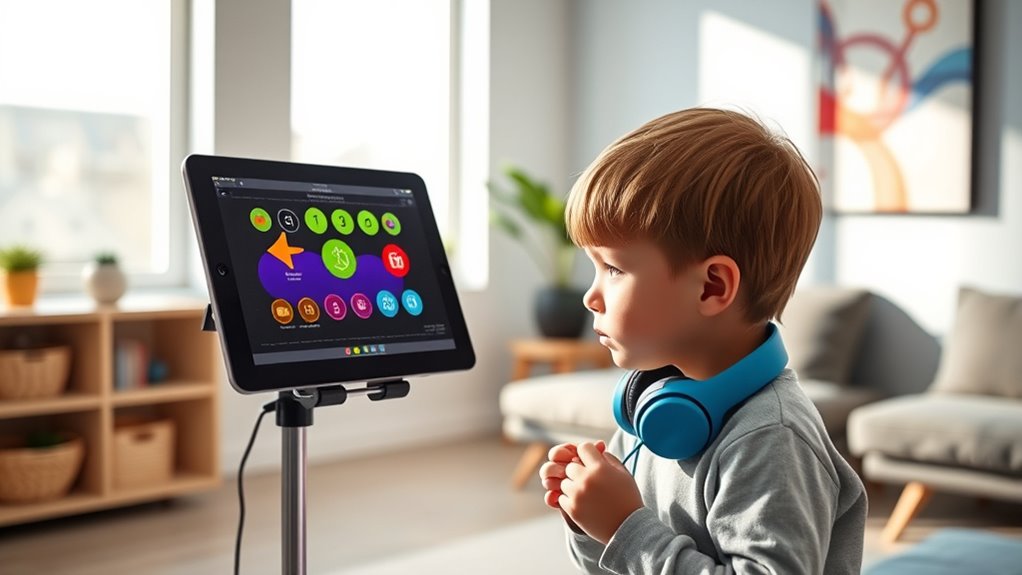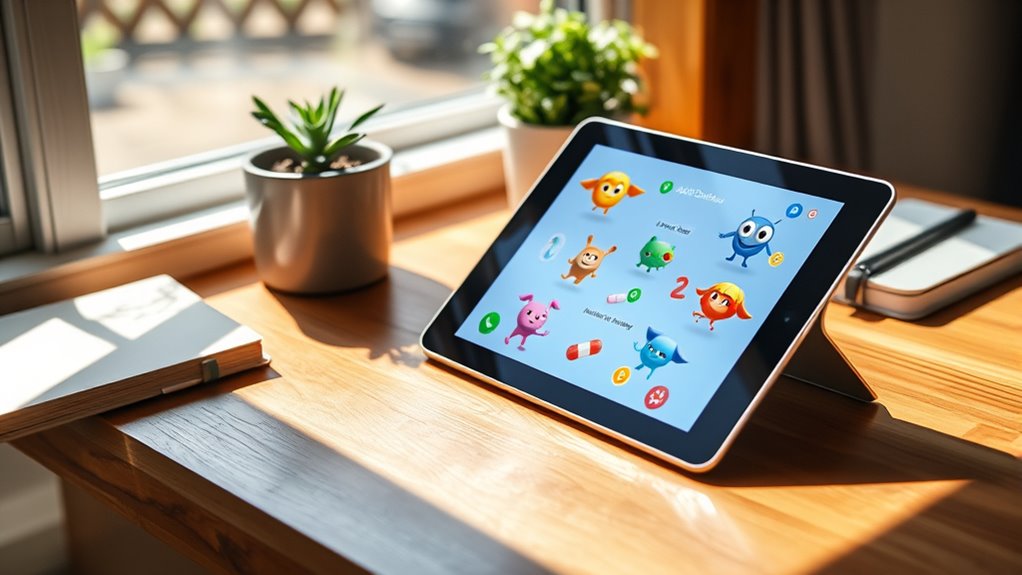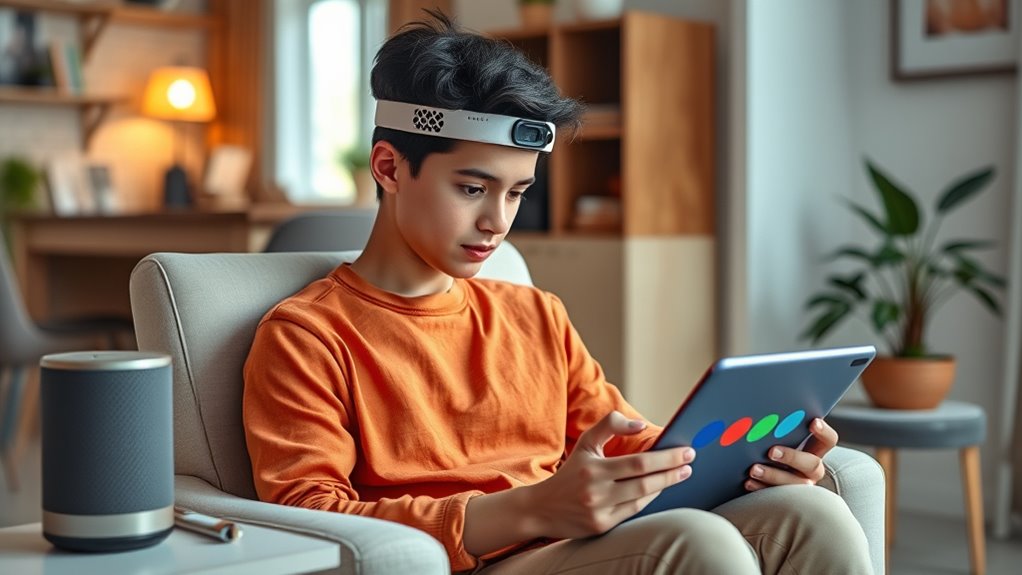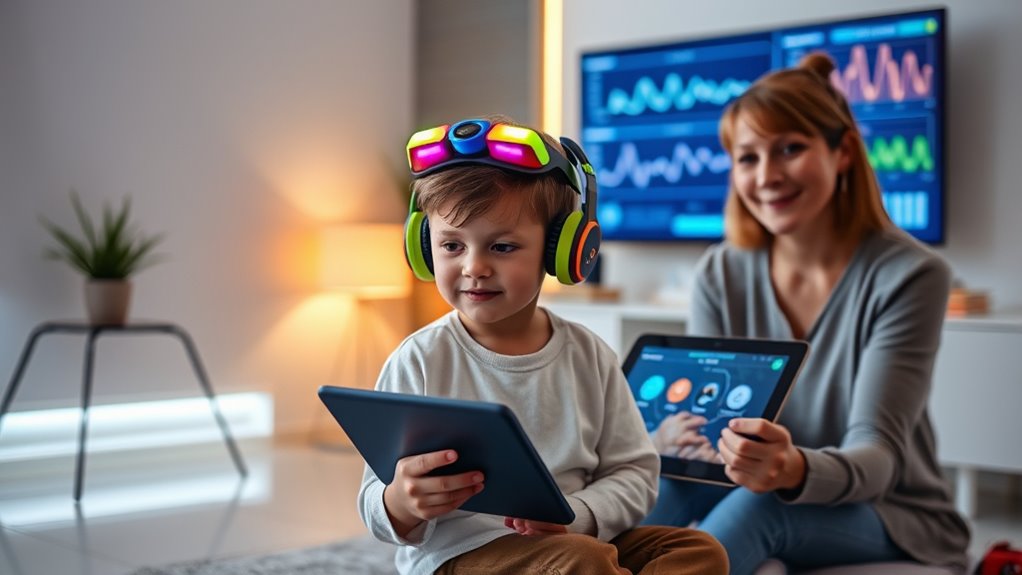Digital therapeutics are increasingly effective for managing ADHD without pills. They include apps and virtual reality tools that improve focus, impulse control, and emotional regulation through engaging exercises and real-world simulations. These personalized, accessible options use evidence-based methods like cognitive training and mindfulness, helping you develop skills naturally. By integrating technology into your daily routine, you’ll find new ways to manage symptoms safely. Keep exploring to discover how these innovative tools can transform your approach to ADHD.
Key Takeaways
- Digital therapeutics like cognitive training apps improve attention and self-regulation without medication.
- Virtual reality environments help practice real-life coping strategies safely and engagingly.
- Wearable devices track symptoms and provide real-time feedback to support natural ADHD management.
- Gamified digital tools motivate consistent practice and enhance focus through interactive challenges.
- Evidence from studies shows digital interventions effectively reduce ADHD symptoms without pharmaceutical side effects.
How Digital Tools Are Changing ADHD Management

Digital tools are transforming how we manage ADHD by providing accessible, personalized support outside traditional medication. These tools open up new medication alternatives and therapy options that cater to your unique needs. Instead of relying solely on pills, you can use apps and digital programs designed to improve focus, organization, and emotional regulation. They help you track symptoms, set goals, and develop coping strategies in real time. Many digital therapeutics offer interactive exercises, mindfulness practices, and cognitive training tailored to your specific challenges. This shift empowers you to take control of your treatment plan, making therapy options more flexible and engaging. Additionally, the integration of data privacy measures ensures that your personal information remains secure while managing your condition. As a result, managing ADHD becomes more approachable, with digital solutions complementing or even replacing traditional medication in some cases.
Types of Digital Therapeutics for ADHD

You can explore cognitive training tools that help improve attention and executive functions through targeted exercises. Virtual reality interventions offer immersive environments to practice skills in engaging, real-world scenarios. Both types of digital therapeutics provide innovative ways to manage ADHD symptoms without medication. Additionally, these digital solutions often incorporate cultural awareness to enhance user engagement and effectiveness.
Cognitive Training Tools
Cognitive training tools have emerged as a promising approach for managing ADHD symptoms without medication. One popular method is neurofeedback therapy, where you learn to regulate brain activity through real-time feedback, improving focus and impulse control. Additionally, gamified exercises make cognitive training engaging by turning tasks into interactive challenges. These digital tools target specific cognitive skills like attention, working memory, and self-regulation, helping you develop better control over ADHD symptoms. By providing immediate feedback and motivating rewards, they encourage consistent practice. Unlike traditional therapies, these tools are accessible anytime and can be tailored to your individual needs. Moreover, the power of electric dirt bikes demonstrates how innovative technology can enhance performance and engagement in various fields, including health and wellness. Overall, cognitive training tools offer a practical, non-invasive way to enhance your cognitive function and manage ADHD symptoms effectively.
Virtual Reality Interventions
Although virtual reality (VR) interventions are still emerging, they offer innovative ways to manage ADHD symptoms by immersing you in controlled, interactive environments. VR provides sensory integration, helping you improve focus, attention, and impulse control through engaging simulations tailored to your needs. These interventions can recreate real-life scenarios, allowing you to practice coping strategies in a safe space. By stimulating multiple senses simultaneously, VR enhances your ability to process sensory information and regulate responses. This immersive approach keeps you actively involved, making therapy more engaging and effective. As technology advances, VR-based digital therapeutics hold promise for personalized, accessible ADHD treatment without medication. They represent a cutting-edge frontier for improving attention and executive functioning in a highly interactive way. Sensory processing is a key aspect of how VR interventions can improve focus and self-regulation in individuals with ADHD.
Benefits of Non-Pharmaceutical Approaches

Non-pharmaceutical approaches offer personalized digital interventions that adapt to your specific needs. They typically come with fewer side effects, making them a safer alternative to medication. Plus, they can help improve your focus and bring a sense of calm to daily life. Incorporating practical tools rooted in evidence-based insights can further support your journey toward mindful clarity and balanced attention.
Personalized Digital Interventions
Personalized digital interventions offer a tailored approach to managing ADHD symptoms without relying on medications. These tools use personalized algorithms to adapt activities and strategies based on your unique needs, improving engagement and effectiveness. You benefit from real-time adjustments that keep you challenged yet not overwhelmed. Additionally, data security is a priority, ensuring your sensitive information stays protected. Imagine a system that evolves with your progress, providing targeted support whenever you need it. To illustrate, consider this table:
| Feature | Benefit |
|---|---|
| Personalized algorithms | Customizes activities for your needs |
| Data security | Keeps your information safe and private |
| Real-time adjustments | Responds instantly to your progress |
| User engagement | Maintains motivation and focus |
These interventions empower you to manage ADHD effectively, safely, and personally. Understanding the importance of contrast ratio in image quality can help explain how visual feedback in digital tools enhances user experience.
Fewer Side Effects
By choosing digital therapeutics and other non-pharmaceutical approaches, you substantially reduce the risk of experiencing unwanted side effects often associated with medications. Traditional therapy and medication can cause medication side effects like sleep issues, appetite changes, or mood swings. Digital options, however, focus on behavioral strategies, cognitive exercises, and skill-building without introducing chemical substances into your body. This means you avoid the sometimes uncomfortable or harmful side effects linked to pills, such as fatigue or dependency risks. Non-pharmaceutical treatments offer a safer alternative, especially for those sensitive to medication or concerned about long-term effects. By opting for these approaches, you can manage ADHD symptoms effectively while maintaining a better overall sense of well-being and avoiding the potential pitfalls of traditional therapy with medication.
Enhanced Focus and Calm
Digital therapeutics can substantially enhance your ability to focus and stay calm by using targeted behavioral and cognitive strategies. Techniques like mindfulness meditation help you develop awareness of your thoughts and feelings, reducing impulsivity and stress. Regular practice trains your brain to maintain attention and stay grounded during challenging moments. Additionally, nutritional supplements can support brain health, improving overall focus and emotional regulation. These approaches work together without the side effects associated with medication, empowering you to manage ADHD symptoms naturally. By integrating mindfulness and proper nutrition into your routine, you create a foundation for sustained calmness and sharper focus. Digital therapeutics make these strategies accessible and effective, offering a practical way to improve your mental clarity and emotional balance. Incorporating well-being tips can further optimize your mental health and resilience.
Evidence Supporting Digital Interventions

Recent studies have provided compelling evidence that digital interventions can effectively improve ADHD symptoms. Multiple clinical trials demonstrate strong digital efficacy, showing significant reductions in inattentiveness, hyperactivity, and impulsivity. These trials involve diverse populations, confirming that digital tools like apps and online programs are adaptable and scalable. For example, some studies report improved executive functioning and emotional regulation following targeted digital therapy sessions. The data suggests that digital interventions are not only effective but also practical, offering accessible alternatives to medication. Additionally, ongoing research into AI safety measures ensures that digital therapeutics maintain high standards of security and reliability. As research continues, the growing body of evidence underscores that digital therapeutics are a credible and promising option for managing ADHD, providing personalized support that complements traditional treatments.
Integrating Technology Into Daily Routines

Incorporating technology into your daily routines can substantially enhance the management of ADHD symptoms. Wearable devices help you track activity levels, sleep patterns, and focus times, providing real-time feedback that encourages healthier habits. Using gamified apps makes routine tasks more engaging, turning chores or study sessions into rewarding challenges. These tools promote consistency by integrating seamlessly into your day, helping you stay organized and focused. For example, setting reminders through wearable alerts or completing tasks within game-like apps can boost motivation and accountability. When you combine these technologies with your daily schedule, you create an environment that supports improved attention, reduced impulsivity, and better overall management of ADHD symptoms. Additionally, understanding side effects of various interventions can help you make informed choices about which tools best suit your needs, ensuring a safer and more effective management plan. This integration makes routines more interactive and tailored to your needs.
Future Trends in Digital ADHD Treatment

As technology continues to evolve, we can expect groundbreaking advancements that will reshape ADHD treatment. Future trends include more personalized digital therapeutics tailored to individual needs, enhancing effectiveness and engagement. Wearable devices and real-time data collection will enable continuous monitoring, empowering you to manage symptoms proactively. However, as digital solutions become more prevalent, concerns around digital stigma might arise, potentially deterring some from seeking help. Ethical considerations will also play a pivotal role, especially regarding data privacy and consent. Developers and clinicians will need to prioritize transparency and safeguard your information. Additionally, understanding the father-daughter bond and its influence on behavior can inform more empathetic and effective therapeutic approaches. Overall, these innovations promise more accessible, stigma-free support for ADHD, but staying informed about ethical practices remains essential for maximizing benefits and minimizing risks.
Frequently Asked Questions
Are Digital Therapeutics Suitable for All Age Groups With ADHD?
You might wonder if digital therapeutics suit everyone with ADHD. While they offer promising solutions, age adaptability varies—what works for a child may not suit an adult. User engagement is essential; younger users often find interactive features appealing, but older users might need tailored approaches. Overall, these tools are versatile, but effectiveness depends on individual needs and how well they match your age group and engagement preferences.
How Do Digital Tools Compare in Effectiveness to Traditional Medication?
Your question about digital tools versus traditional medication is like comparing a lightning bolt to a gentle breeze. Digital engagement and symptom tracking empower you to manage ADHD actively, often matching or surpassing medication’s effectiveness. While medication can provide quick relief, digital therapeutics foster long-term habits and insight. Many find these tools more personalized and less invasive, making them a powerful complement or alternative to pills in managing ADHD symptoms effectively.
What Are Potential Privacy Concerns With Digital ADHD Interventions?
You might worry about privacy when using digital ADHD interventions. These tools collect sensitive data, so data security is vital to protect your information. If not properly secured, your user privacy could be at risk, leading to potential misuse or breaches. Always check the app’s privacy policies and security measures to guarantee your data is handled responsibly, giving you peace of mind while benefiting from these innovative solutions.
Can Digital Therapeutics Replace Therapy or Counseling for ADHD?
You might wonder if digital therapeutics can replace therapy or counseling for ADHD. While they boost digital engagement and enable symptom tracking, they often serve as complementary tools rather than replacements. Therapy offers personalized support and emotional connection, which digital solutions can’t fully replicate. So, digital therapeutics can enhance your management plan, but for holistic care, professional therapy remains essential.
Are There Any Risks or Side Effects Associated With Digital ADHD Treatments?
You might wonder if digital ADHD treatments have side effect risks or privacy concerns. While generally safe, some risks include data privacy issues and potential overuse or dependency on digital tools. Unlike medication, they don’t have physical side effects, but you should stay cautious about sharing personal info and make sure the platform is secure. Always research and consult healthcare providers to minimize risks and protect your privacy.
Conclusion
As you embrace these digital therapeutics, you’re opening a new chapter where technology becomes your guiding star, illuminating pathways to better focus and self-control. Like a skilled navigator, these tools steer you through the turbulent seas of ADHD without the need for pills. With each click and tap, you’re forging a future where your mind’s landscape is painted with clarity and confidence. Embrace this digital dawn—your journey to thriving begins now.










